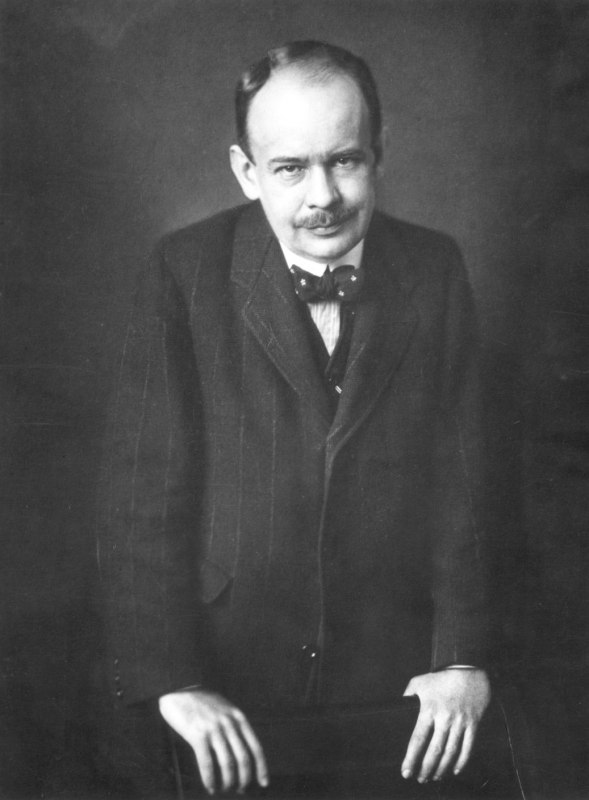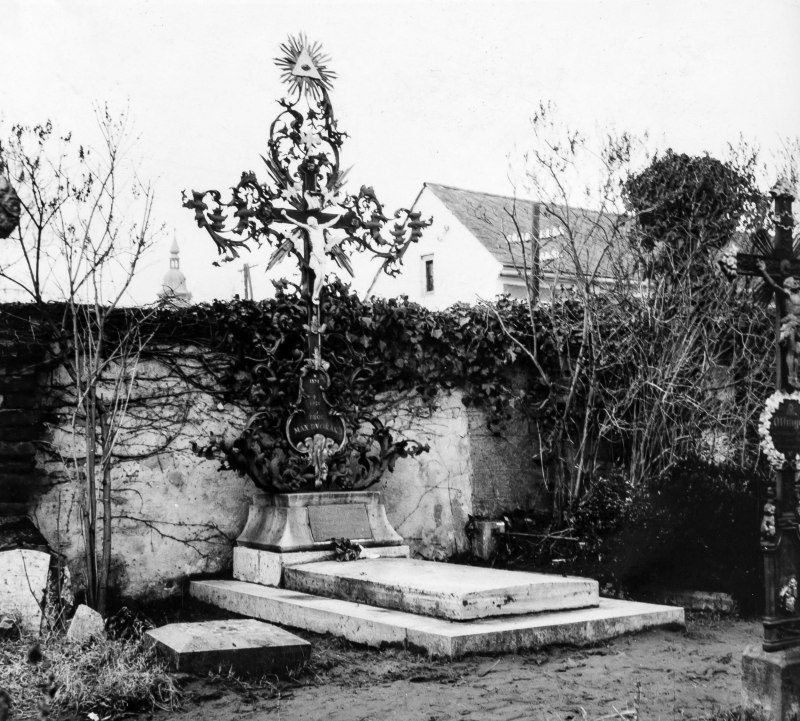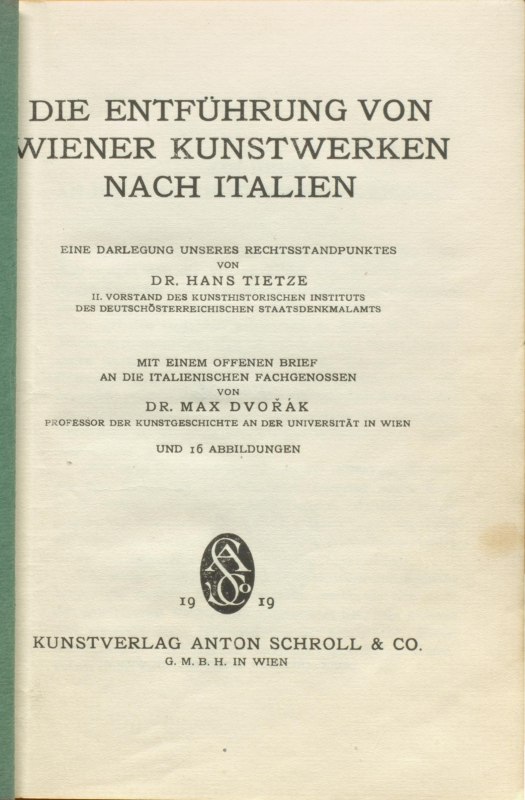Max Dvořák, Prof.
Professor of art history, one of the main representatives of the Vienna School of art history, monument conservator, art conservationist
Honors
| Ehrung | Titel | Datierung | Fakultät | |
|---|---|---|---|---|
| Commemorative Plaque of Faculty | 1962 | Faculty of Philosophy |
Die Eintragung des Namens des ehemaligen Ordinarius für Kunstgeschichte an der Universität Wien Max Dvořák in die Ehrentafel der Philosophischen Fakultät erfolgte auf Antrag seines Schülers Karl Maria Swoboda aus Anlass dessen 40. Todestages im Frühjahr 1961, da:
Die mit dieser Frage betraute Kommission der Philosophischen Fakultät, bestehend aus Dekan Ferdinand Steinhauser und den Professoren Swoboda, Fritz Eichler, Alfons Lhotsky, Hugo Hantsch und Eberhard Clar, stimmte dem Antrag am 1. Dezember 1961 einstimmig zu. Das Professorenkollegium der Fakultät gab am 16. Dezember 1961 seine Zustimmung, der Senat der Universität Wien am 20. Jänner 1962. Am 6. Februar 1962 beauftragte Rektor Franz Arnold die Universitäts-Gebäudeverwaltung mit der Durchführung der Eintragung. The name of the former full professor of art history at the University of Vienna, Max Dvořák, was inscribed in the Faculty of Philosophy's Commemorative Plaque of honor at the request of his student and successor Prof. Karl Maria Swoboda on the occasion of the 40th anniversary of his death in spring 1961, as:
The Faculty's committee, consisting of Dean Ferdinand Steinhauser and professors Swoboda, Fritz Eichler, Alfons Lhotsky, Hugo Hantsch and Eberhard Clar, unanimously approved the application on December 1st, 1961. The Faculty's Board of Professors gave its approval on December 16th, 1961, and the Senate of the University of Vienna on January 20th, 1962. On February 6th, 1962, Rector Franz Arnold, instructed the University Building Administration to carry out the inscription. |
- Art History
- History
- Faculty of Philosophy
Biographical and educational background
Born in Raudnitz an der Elbe in Bohemia in 1874, the son of a princely Lobkowitz archivist and librarian studied history at the Czech University of Prague and continued his studies at the University of Vienna, where he also became a member of the Institute for Austrian Historical Research in 1895-97 and received his philosophical doctorate in history on March 31, 1897 for his dissertation “Quellenuntersuchungen zu Kosmas von Prag“.
Under the influence of the art historians Alois Riegl and Franz Wickhoff, he turned to art history, became Wickhoff's assistant in 1898 and habilitated as a private lecturer in art history at the University of Vienna in 1902 with a thesis on Bohemian manuscript painting of the thirteenth and fourteenth centuries. Following Alois Riegl, he became an associate professor in 1905, despite anti-Czech resentment, and also General Conservator of the Central Commission for the Conservation of Art and Historical Monuments (today's Federal Monuments Office). He became a full professor in 1909. In the same year, the Graz art historian Josef Strzygowski was appointed as Franz Wickhoff's successor at the University of Vienna and, due to incompatibilities, the art history department was split into two separate institutes. Max Dvořák, was the director of the Second Institute of Art History.
He was married to Gisela Hislik, with whom he also had two daughters, and was re-married to Rosa Jovanovič, widowed Seatovič, in 1911.
Art historian | Viennese school of art history
He sought to continue the tradition of the Viennese School of Wickhoff and Riegl and, on the one hand, to develop art history into the most exact science possible based on strict historical-philological research and, on the other, to provide a new, intellectual-historical interpretation of art historical phenomena. The methodology of the Viennese School is described as a triangle consisting of the historical approach of Dvořák, the stylistic approach of Wickhoff and the linguistic-historical approach of Riegl/Schlosser (Edwin Lachnit). Together, these four form the Viennese School of the early 20th century.
Methodologically, Dvořák used Riegl's evolutionary model of art history in his early work and described (e.g. in his habilitation) the “great stream of artistic development.“ He used a strongly formal analysis of objects and argued, for example in The Enigma of the Art of the Van Eyck Brothers, for a linear development of art based on stylistic analysis.
He rejected the naturalism of van Eyck as a sudden phenomenon and instead traced the continuous development from the realism of the Quattrocento through French manuscript illumination to the painting of the Northern Renaissance. His late work increasingly reveals his conviction that the spiritual content resulting from the object and form is the key to understanding.
Instead of a precise, connoisseurial reading of individual works, Dvořák opted for more comprehensive historical principles in his later writings. This intellectual-historical method is best demonstrated in his work Idealism and Naturalism in Gothic Sculpture and Painting (1918, Engl. 1967), in which he argues, among other things, that the degree of realism of an art object reflects an artist's personal expression and not a struggle between abstraction and naturalism. The works of Otto Benesch and Hans Tietze both build on this method.
Hans Tietze emphasized in his obituary that Dvořák
“had begun as a pure historian and, equipped with the full tools of this older science, came to art history through Wickhoff and Riegl. Their overcoming of aesthetic dogmatism, as Dvořák himself characterized it in his obituary for Riegl, prepared the ground for him - he took over from them the science of art as a historical discipline - with all the dangers of this attitude. For the absoluteness of the work of art and the relativity of all historical knowledge stand in stark contrast; it was in the nature of the last generation of the last century - the period of scientific orientation and Impressionism - to bridge this gap through the concept of artistic autonomy. The works of art, detached from the aesthetic bond and deprived of essential elements through their conception as mere historical fact, are united by their own lawfulness to form a development, they form series whose physical connection is based on the special nature of the isolated works of art.
The space and time boundaries drawn by history do not exist for its world, and so the evolutionist interpretation of art shatters historical dogmatism. The historical life of art does not take place within nations and not within stylistic periods; it spills out and over, a stream that digs its own bed. An attitude like this must preferably cultivate all transitional areas. It is no coincidence that Wickhoff's and Riegl's great works are dedicated to stylistic borderline issues and that Dvořák, in his first works, also had to participate in this liberation of art history from alien spiritual bonds.“
Monument preservation
In 1905, Max Dvořák succeeded Alois Riegl (1858-1905) as General Conservator of the k.k. Central Commission for the Research and Preservation of Artistic and Historical Monuments (today's Federal Monuments Office) until 1910 and compiled the “Catechism of Monument Preservation“ (1916/18²), which, based on Riegl's theoretical approach and significantly influenced by Archduke Franz Ferdinand in its structure, illustrates the principles and guidelines of monument preservation using concrete examples and (negative) counter-examples.
He later became head of the art history institute of the now k.k. Central Commission for the Preservation of Monuments, which was entrusted with the recording of the monument inventory, basic research and the publication of major inventories such as the Kunsttopographie and later the Dehio handbooks.
Dvořák took his position as a public monument conservator very seriously and helped to save many Austrian art treasures from reparations after the First World War. He continued the publication of the Kunstgeschichtliche Jahrbuch der Zentralkommission für die Erhaltung der Kunst- und historischen Denkmale and the compilation of an inventory of Austrian and Hungarian monuments, the “Österreichische Kunsttopographie“ (1907), and also collaborated on the “Böhmische Kunsttopographie“ and continued the cataloging of the “Österreichische Illuminierte Handschriften“ begun by Wickhoff.
His responses to heritage conservation issues in Vienna, Krakow (Wawel) and Split (Diocletian's Palace) are analyzed in detail as representative case studies from the center and periphery of the empire, where modern heritage conservationists fought a battle on two fronts against the encroachments of modernism on the one hand and the destructive practices of 19th century restoration on the other.
The state administration of cultural heritage in late Habsburg Austria with its various peoples, languages and histories was also an inherently political matter for him and was part of a cultural effort to preserve the empire itself.
Museum Commission | Protection of Art Assets
As an expert accepted by all conflicting actors and with his extensive organizational experience, he was also commissioned after the collapse of Austria-Hungary in 1918 to ensure that the Austrian art holdings remained in Austria (largely in Vienna), against the partly justified, interests of the other successor states of the monarchy in the former private property of the abdicated imperial family, but also against the efforts of the Austrian administration to sell art assets (such as the imperial tapestries) in the times of need after the First World War to procure food and pay reparations.
Dvořák was appointed by Otto Glöckl as chairman of the museum commission initiated by Hans Tietze (1919), which was to preserve and reorganize the art and cultural heritage, and also became a member of the Academy of Sciences in Vienna (1920), head of the art history institute of the State Monuments Office, member of the archaeological institute in Vienna, etc. Until 1920/21 - with the intensive support of Hans Tietze - he was largely successful in his efforts to ensure that the collections kept in Vienna remained there.
His widely published “open letter to his Italian colleagues“ in Hans Tietze's book “Die Entführung von Wiener Kunstwerken nach Italien“ (1919), when an Italian reparations commission raided and removed works of art from the Kunsthistorisches Museum and the Treasury and took them to Italy, is legendary.
During this time, he turned down an attractive offer to teach at the newly founded University of Cologne in 1920.
Works
Only a few of his numerous publications are mentioned here:
- Über den byzantinischen Einfluß auf die italienische Miniaturkunst des Trecento, in: Mitteilungen des Österreichischen Instituts für Geschichtsforschung Erg. Vol. 6 (1900).
- The illuminators of Johann von Neumarkt [Habilitation], in: Jahrbuch der Kunsthistorischen Sammlungen des Allerhöchsten Kaiserhauses (1901), 35-127.
- Das Rätsel der Kunst der Brüder van Eyck, in: Jahrbuch der Kunsthistorischen Sammlungen des Allerhöchsten Kaiserhauses 24 (1904), 161-317.
- Katechismus der Denkmalpflege, Wien 1916, 1918².
- Idealismus und Naturalismus in der gotischen Skulptur und Malerei, in: Historische Zeitschrift 119 (1918): 1-62, 185-246 (reprint Berlin, Boston 2019).
- Geschichte der italienischen Kunst im Zeitalter der Renaissance, 2 vols., Munich 1927/28.
- Kunstgeschichte als Geistesgeschichte: Studien zur abendländischen Kunstentwicklung (ed. by K. M. Swoboda), Munich 1924.
- Gesammelte Aufsätze zur Kunstgeschichte (ed. by K. M. Swoboda and J. Wilde), Munich 1929.
- Preface, in: Oskar Kokoschka: Variationen über ein Thema, Vienna 1921.
- The paintings of Peter Bruegel the Elder, Vienna, 1942.
- El Greco and Mannerism, in: The Magazine of Art, Vol. 46 no. 1 (1953), pp. 14-23.
- Idealism and Naturalism in Gothic Art, Notre Dame, IN, 1967.
- The History of Art as the History of Ideas, Boston, 1984.
He died unexpectedly at the age of only 47 from a stroke during a vacation in Grusbach Castle [Hrušovany nad Jevišovkou\ near Znojmo], Czech Republic, and is buried in a traditional grave in the cemetery there (the baroque grave cross was donated by Prince Johann II v.u.z. Liechtenstein), although Adolf Loos had designed a modernist mausoleum for him, which was not realized.
Honors
A monument was immediately erected in his birthplace Roudnice nad Labem (Raudnitz), in March 1924 a street in Vienna 13th, Speising was renamed “Dvorakgasse“ in his honor and on the occasion of the 40th anniversary of his death his name was added to the honorary plaque of the Faculty of Philosophy in 1961/62 in the auditorium of the main building at the University of Vienna.
Numerous exhibitions and congresses were held to mark the 100th anniversary of his death, with many participants from Austria, the Czech Republic, Slovakia, Italy, the USA and Hungary in 2021.
Archive of the University of Vienna/final examination registry and file (“Rigorosenakt“) PHIL RA 1031; graduation registry (“Promotionsprotokoll“) M 34.2 PHIL (1881-1905) No. 750; PHIL personnel file PH PA 1514; personnel file Senate S 304.192; Senate GZ 6 ex 1961/62; PHIL GZ 117 ex 1960/61;
Archive of the Institute of Art History of the University of Vienna, Max Dvorak estate
Zuletzt aktualisiert am 04/21/24




